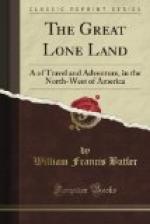spots had this huge animal throughout the great domain
over which he roamed-many beautiful scenes where,
along river meadows, the grass in winter was still
succulent and the wooded “bays” gave food
and shelter, but-no more favourite ground than this
valley of the Saskatchewan; thither he wended his
way from the bleak plains of the Missouri in herds
that passed and passed for days and nights in seemingly
never-ending numbers. Along the countless creeks
and rivers that add their tribute to the great stream,
along the banks of the Battle River and the Vermilion
River, along the many White Earth Rivers and Sturgeon
Creeks of the upper and middle Saskatchewan, down through
the willow copses and aspen thickets of the Touchwood
Hills and the Assineboine, the great beasts dwelt
in all the happiness of calf-rearing and connubial
felicity. The Indians who then occupied these
regions killed only what was required for the supply
of the camps-a mere speck in the dense herds that
roamed up to the very doors of the wigwams; but when
the trader pushed his adventurous way into the fur
regions of the North, the herds of the Saskatchewan
plains began to experience a change in their surroundings.
The meat, pounded down` and mixed with fat into “pemmican,”
was found to supply a most excellent food for transport
service, and accordingly vast numbers of buffalo were
destroyed to supply the demand of the fur traders.
In the border-land between the wooded country and the
plains, the Crees, not satisfied with the ordinary
methods of destroying the buffalo, devised a plan
by which great multitudes could be easily annihilated.
This method of hunting, consists in the erection of
strong wooden enclosures called pounds, into which
the buffalo are guided by the supposed magic power
of a medicine-man. Sometimes for two days the
medicine-man will live with the herd, which he half
guides and half drives into the enclosures; sometimes
he is on the right, sometimes on the left, and sometimes,
again, in rear of the herd, but never to windward
of them. At last they approach the pound, which
is usually concealed in a thicket of wood. For
many miles from the entrance to this pound two gradually
diverging lines of tree-stumps and heaps of snow lead
out into the plains. Within these lines the buffalo
are led by the medicine-man, and as the lines narrow
towards the entrance, the herd, finding itself hemmed
in on both sides, becomes more and more alarmed, until
at length the great beasts plunge on into the pound
itself, across the mouth of which ropes are quickly
thrown and barriers raised. Then commences the
slaughter. From the wooded fence around arrows
and bullets are poured into the dense plunging mass
of buffalo careering wildly round the ring. Always
going in one direction, with the sun, the poor beasts
race on until not a living thing is left; then, when
there is nothing more to kill, the cutting-up commences,
and pemmican-making goes on.




